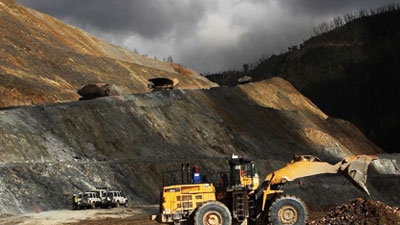- PNG’s economy continued to expand strongly through the second half of 2011 and into early 2012. Over 2011, the economy is likely to have expanded by 9 to 10 percent, driven by the direct and spin-off investments in future resource production, high commodity prices and supportive agricultural conditions, as well as government spending. The strength of these drivers is likely to have peaked around the turn of 2012, especially as the appreciated Kina and weakening global commodity prices start to drag rural incomes and government revenues. Growth in prices across the economy, while still high, moderated.
- Ongoing construction of the PNG-LNG project continued to be the major factor driving PNG’s economic expansion. The USD 15.7 billion investment is at its peak of activity. The first gas delivery is still expected in late 2014. Meanwhile, minerals and oil & gas production continued to subtract from growth.
- Inflation, while remaining high, peaked in the first half of 2011. The official urban consumer price index inflation rate moderated from its recent peak near 10 percent over the year to Q2 2011 to 6.9 percent in the year to Q4 2011 and 4.0 percent in the year to Q1 2012. Volatile prices and the stabilization in fuel prices explained much of the slowing in late 2011, with underlying inflation remaining stronger, at around 7¾ percent in the year to Q4 2011. The introduction of the tuition fee-free education policy subtracted approximately 2½ percentage points from inflation in Q1 2012. Domestic prices continued to outpace imported prices through 2011, a recent reversal of the historical pattern in PNG. Inflation is likely to remain above 5 percent into the medium-term, with risks of higher default rates as demand growth moderates.
- The Kina appreciated to near 2 Kina per USD by March 2012, 9 percent stronger than in September 2011 and 25 percent stronger than a year earlier; it stabilized near that rate through to mid-June.
- Market rates generally remained low. Banks reported that the rises in the central bank’s reserve requirement had raised their costs, but this appears to have only temporarily raised interest rates on loans, deposits or short-term paper. Rates on central bank and Treasury paper rose by 1 to 1¾ percentage points in the first six months of 2011 with the increase in the KFR, reserve requirements and increased central bank bill issuance.
- Official public debt, near 25 percent of GDP, is assessed to be sustainable, and the underlying dynamics are favorable. This debt includes only those liabilities currently on the government’s balance sheet.
- PNG’s non-mineral economy is likely to moderate through to 2015, as construction of the LNG plant winds down, and the retreat in cash crop and other commodity prices combines with the stronger PGK to dampen real incomes. These factors are likely to slow growth in the non-mineral economy to below 5 percent by 2014
- The government took an important step towards improving the effectiveness with which natural resource revenues can be translated into public goods and services by passing the Organic law (constitutional amendment) establishing a PNG Sovereign Wealth Fund (SWF).

